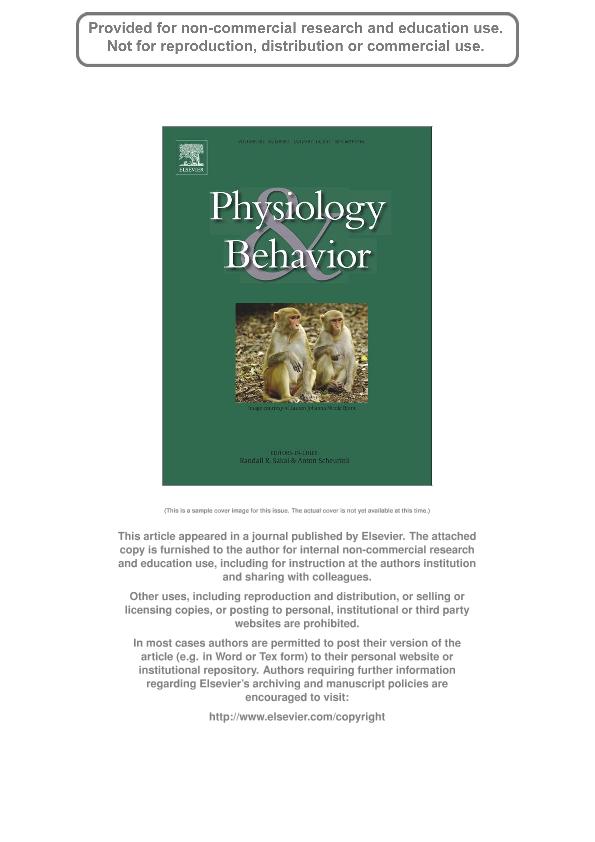Mostrar el registro sencillo del ítem
dc.contributor.author
Macchione, Ana Fabiola

dc.contributor.author
Caeiro, Ximena Elizabeth

dc.contributor.author
Godino, Maria Andrea del Milagro

dc.contributor.author
Amigone, Jorge Luis

dc.contributor.author
Antunes Rodrigues, Jose

dc.contributor.author
Vivas, Laura Marta

dc.date.available
2021-04-06T22:12:25Z
dc.date.issued
2012-02
dc.identifier.citation
Macchione, Ana Fabiola; Caeiro, Ximena Elizabeth; Godino, Maria Andrea del Milagro; Amigone, Jorge Luis; Antunes Rodrigues, Jose; et al.; Availability of a rich source of sodium during the perinatal period programs the fluid balance restoration pattern in adult offspring; Pergamon-Elsevier Science Ltd; Physiology And Behavior; 105; 4; 2-2012; 1035-1044
dc.identifier.issn
0031-9384
dc.identifier.uri
http://hdl.handle.net/11336/129485
dc.description.abstract
Osmoregulatory mechanisms can be vulnerable to electrolyte and/or endocrine environmental changes during the perinatal period, differentially programming the developing offspring and affecting them even in adulthood. The aim of this study was to evaluate whether availability of hypertonic sodium solution during the perinatal period may induce a differential programming in adult offspring osmoregulatory mechanisms. With this aim, we studied water and sodium intake after Furosemide-sodium depletion in adult offspring exposed to hypertonic sodium solution from 1. week before mating until postnatal day 28 of the offspring, used as a perinatal manipulation model [PM-Na group]. In these animals, we also identified the cell population groups in brain nuclei activated by Furosemide-sodium depletion treatment, analyzing the spatial patterns of Fos and Fos-vasopressin immunoreactivity.In sodium depleted rats, sodium and water intake were significantly lower in the PM-Na group vs. animals without access to hypertonic sodium solution [PM-Ctrol group]. Interestingly, when comparing the volumes consumed of both solutions in each PM group, our data show the expected significant differences between both solutions ingested in the PM-Ctrol group, which makes an isotonic cocktail; however, in the PM-Na group there were no significant differences in the volumes of both solutions consumed after Furosemide-sodium depletion, and therefore the sodium concentration of total fluid ingested by this group was significantly higher than that in the PM-Ctrol group.With regard to brain Fos immunoreactivity, we observed that Furosemide-sodium depletion in the PM-Na group induced a higher number of activated cells in the subfornical organ, ventral subdivision of the paraventricular nucleus and vasopressinergic neurons of the supraoptic nucleus than in the PM-Ctrol animals. Moreover, along the brainstem, we found a decreased number of sodium depletion-activated cells within the nucleus of the solitary tract of the PM-Na group.Our data indicate that early sodium availability induces a long-term effect on fluid drinking and on the cell activity of brain nuclei involved in the control of hydromineral balance. These results also suggest that availability of a rich source of sodium during the perinatal period may provoke a larger anticipatory response in the offspring, activating the vasopressinergic system and reducing thirst after water and sodium depletion, as a result of central osmosensitive mechanism alterations. © 2011 Elsevier Inc.
dc.format
application/pdf
dc.language.iso
eng
dc.publisher
Pergamon-Elsevier Science Ltd

dc.rights
info:eu-repo/semantics/openAccess
dc.rights.uri
https://creativecommons.org/licenses/by-nc-sa/2.5/ar/
dc.subject
FOS-IR CELLS
dc.subject
FUROSEMIDE-SODIUM DEPLETION
dc.subject
HYPERTONIC SODIUM EXPOSURE
dc.subject
PERINATAL MANIPULATION
dc.subject
VASOPRESSIN
dc.subject.classification
Neurociencias

dc.subject.classification
Medicina Básica

dc.subject.classification
CIENCIAS MÉDICAS Y DE LA SALUD

dc.title
Availability of a rich source of sodium during the perinatal period programs the fluid balance restoration pattern in adult offspring
dc.type
info:eu-repo/semantics/article
dc.type
info:ar-repo/semantics/artículo
dc.type
info:eu-repo/semantics/publishedVersion
dc.date.updated
2021-02-18T16:44:29Z
dc.journal.volume
105
dc.journal.number
4
dc.journal.pagination
1035-1044
dc.journal.pais
Estados Unidos

dc.description.fil
Fil: Macchione, Ana Fabiola. Consejo Nacional de Investigaciones Científicas y Técnicas. Centro Científico Tecnológico Conicet - Córdoba. Instituto de Investigación Médica Mercedes y Martín Ferreyra. Universidad Nacional de Córdoba. Instituto de Investigación Médica Mercedes y Martín Ferreyra; Argentina
dc.description.fil
Fil: Caeiro, Ximena Elizabeth. Consejo Nacional de Investigaciones Científicas y Técnicas. Centro Científico Tecnológico Conicet - Córdoba. Instituto de Investigación Médica Mercedes y Martín Ferreyra. Universidad Nacional de Córdoba. Instituto de Investigación Médica Mercedes y Martín Ferreyra; Argentina
dc.description.fil
Fil: Godino, Maria Andrea del Milagro. Consejo Nacional de Investigaciones Científicas y Técnicas. Centro Científico Tecnológico Conicet - Córdoba. Instituto de Investigación Médica Mercedes y Martín Ferreyra. Universidad Nacional de Córdoba. Instituto de Investigación Médica Mercedes y Martín Ferreyra; Argentina
dc.description.fil
Fil: Amigone, Jorge Luis. Hospital Privado Universitario de Córdoba; Argentina
dc.description.fil
Fil: Antunes Rodrigues, Jose. Universidade de Sao Paulo; Brasil
dc.description.fil
Fil: Vivas, Laura Marta. Consejo Nacional de Investigaciones Científicas y Técnicas. Centro Científico Tecnológico Conicet - Córdoba. Instituto de Investigación Médica Mercedes y Martín Ferreyra. Universidad Nacional de Córdoba. Instituto de Investigación Médica Mercedes y Martín Ferreyra; Argentina
dc.journal.title
Physiology And Behavior

dc.relation.alternativeid
info:eu-repo/semantics/altIdentifier/url/http://www.sciencedirect.com/science/article/pii/S003193841100535X
dc.relation.alternativeid
info:eu-repo/semantics/altIdentifier/doi/https://doi.org/10.1016/j.physbeh.2011.11.015
Archivos asociados
